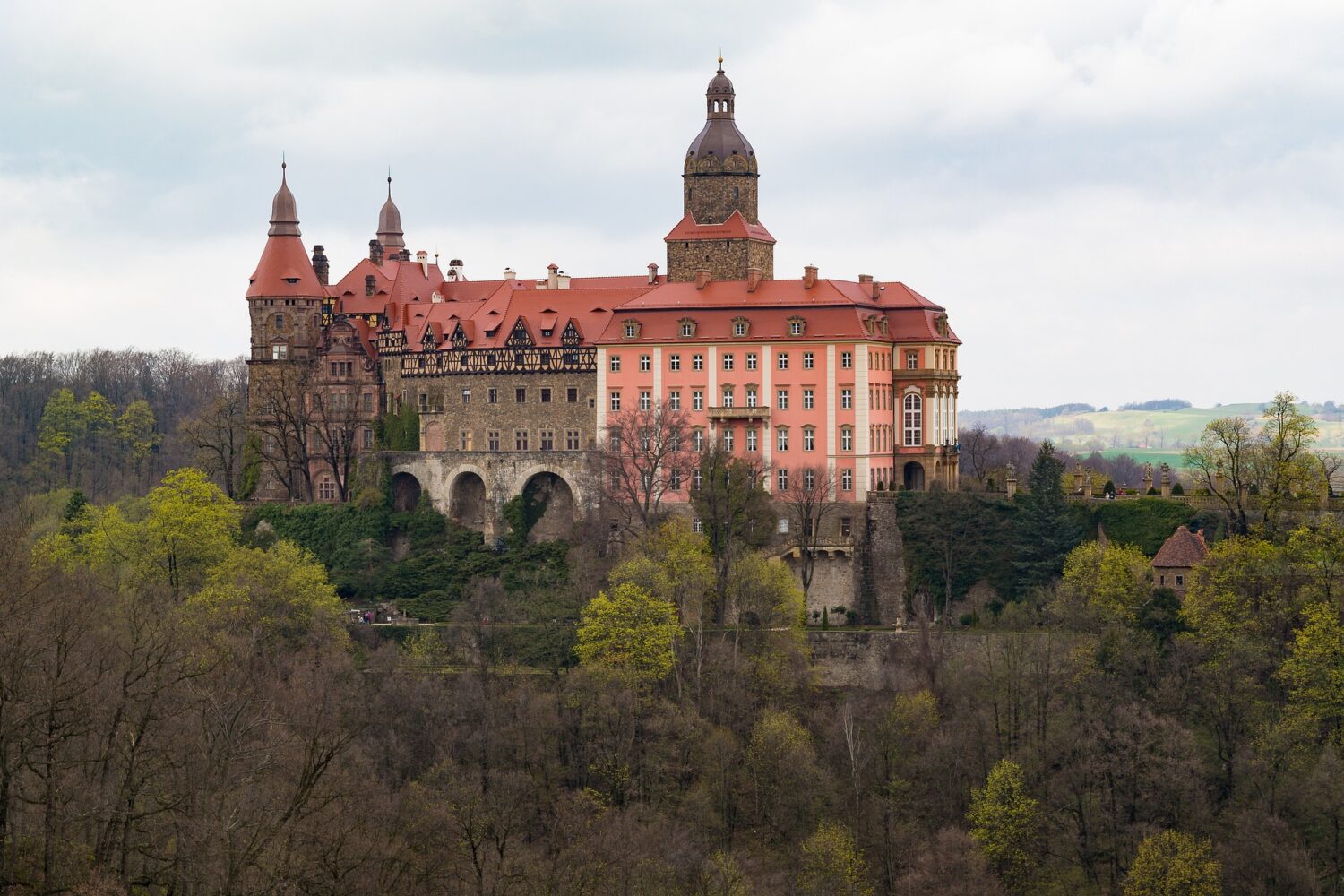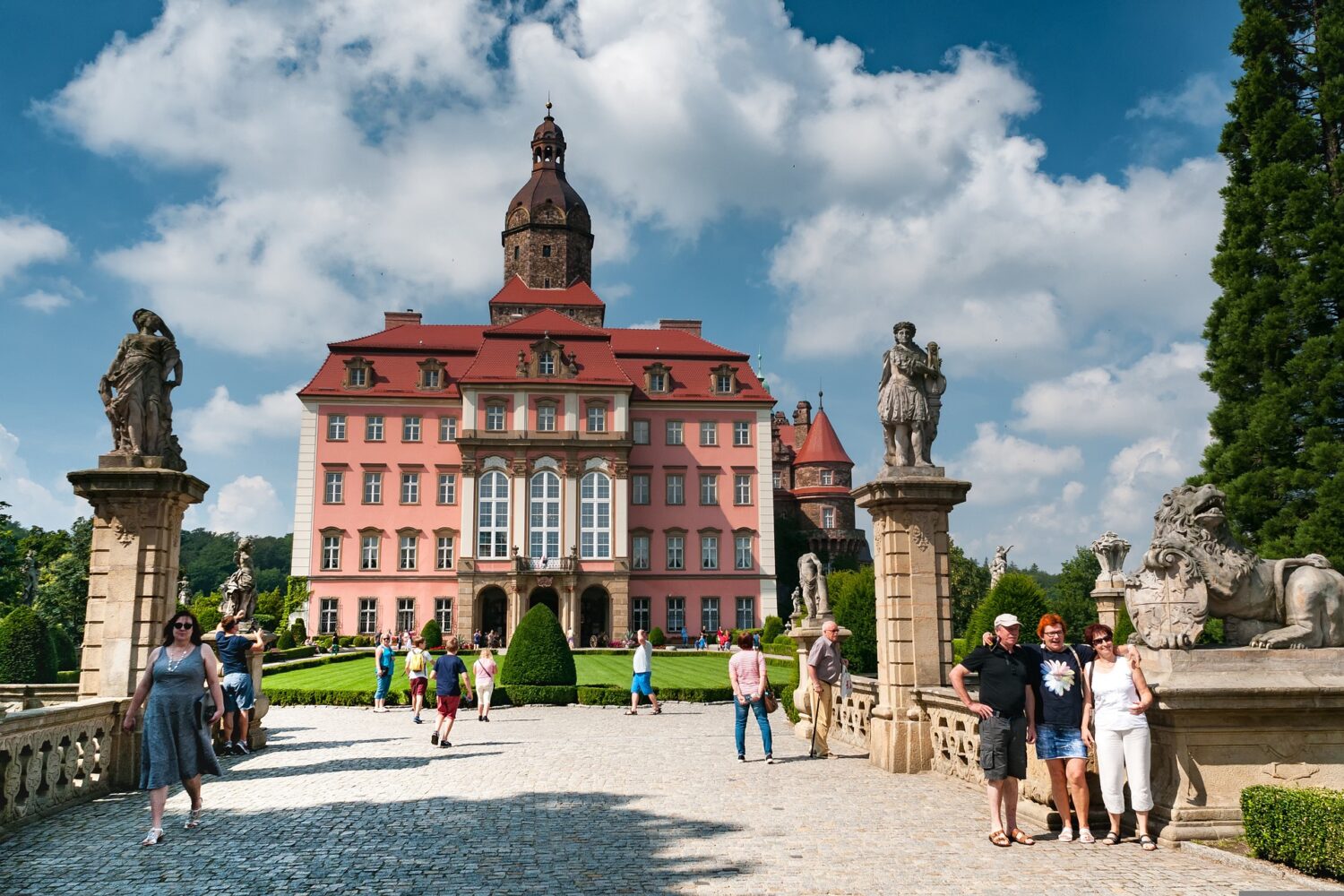Ksiaz Castle
Ksiaz Castle – 13th Century
Ksiaz Castle – updated 13 January 2023.
Ksiaz Castle (German: Schloss Fürstenstein) is a large, impressive castle located in the town of Walbrzych in southwestern Poland. It is considered to be one of the most important and well-preserved castles in Poland.
Hochberg family
The incredibly beautiful and photogenic Ksiaz Castle was originally built in the 13th century as a small fortress, but it was expanded and rebuilt several times over the centuries. The current neo-Gothic style of the castle dates back to the 19th century, when it was rebuilt by the Hochberg family, who were one of the most powerful and wealthy families in the region. The castle was rebuilt in the neo-Gothic style with the intention of creating a residence that would reflect the family’s prestige and power.

Interior
The castle’s interior is just as impressive as its exterior, with beautifully decorated rooms, each with their own unique style. Some of the most notable rooms include the Great Hall, which features frescoes depicting scenes from Greek and Roman mythology, and the Knight’s Hall, which features a fireplace made of black marble.
Lost Nazi gold train
Over the years the castle has been the home to many noble families including the Silesian Duke Bolko 1 (who built it) and the mighty House of Hochberg. The castle is situated in thick woodlands adding to its majesty and is at the heart of a rumour of a lost Nazi gold train believed to be buried in the vicinity of the castle. After the war, the castle was nationalized and passed through different hands and purposes, until it was bought by the local government and opened to the public as a museum and cultural center.
Project Riese
During World War II, the Castle was taken over by the occupying German forces and following Hitler’s direct orders, a system of tunnels was constructed underneath the castle and surrounding areas. The construction was one of seven underground structures all developed under the code name Project Riese.
The function of the tunnels underneath Ksiaz Castle remains unclear mainly due to a lack of documentation; however, it is likely that they were going to be part of the Führer’s Headquarters network.

Disease and malnutrition
The construction of the tunnels within Project Riese was carried out by forced labourers, POWs and prisoners of concentration camps with many losing their lives due to disease and malnutrition.
In 2018, a 1.5km section of the tunnels was opened to the public as a tourist attraction and a 45-minute tour is available.
Renovation
In true form, the Nazi occupiers deliberately destroyed many of the historic chambers within the castle and after the war, the Castle was used as a barracks by the Red Army for a while before becoming largely abandoned. Thankfully, renovation work was undertaken in 1952 to restore the castle back to its former grandeur.
Romanesque, baroque and neo-Renaissance
Since the 13th century, Ksiaz Castle has been remodelled numerous times and today you can see a variety of styles within its architecture including Romanesque, baroque and neo-Renaissance.
Tours of Ksiaz Castle
Ksiaz Castle is open to the public and visitors can take guided tours of the castle’s interior, which includes a variety of exhibitions and displays about the castle’s history, architecture, and the Hochberg family. The castle also has a number of beautiful gardens and parkland that are open to visitors. The castle also serves as a venue for conferences and cultural events.
Maximilian Hall
Visitors today can explore and admire numerous chambers, terraces and the surrounding gardens. The showpiece of the tour is Maximilian Hall with its painted ceiling depicting mythological scenes.
Karkonosze Mountains
The castle is surrounded by a park and a lake, which are also open to the public, and are a popular spot for hiking and picnicking. The castle is located in the Karkonosze Mountains, which is a popular tourist destination for outdoor activities such as hiking and skiing.
National monument
Ksiaz Castle is a national monument and is considered to be one of Poland’s most important historical sites. It is a popular tourist destination, and attracts many visitors each year who are interested in the history and architecture of the castle.
Getting there
The castle is located in the town of Walbrzych in southwestern Poland. The closest airports are Wrocław Copernicus Airport (WRO) and Katowice International Airport (KTW). Visitors can also reach the castle by train or bus. Car is another option which gives you the flexibility to explore the area.
See information about other underground attractions in Poland.